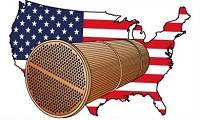Lube oils and the functions it is used for in turbine-generation are necessary for optimal production for the moment, and optimum equipment reliability for the future. Both production and reliability are essential elements of increased profits. For lube oil to do its job it must be kept clean and at the proper temperature. Lube oil coolers are an essential element in this process.
Operation
The primary purpose of lube oil coolers is to cool turbine oil. This is accomplished as the heated oil travels a serpentine path through the shell side of the bundle, while cooling water flows through the tube side. Heat is transferred from the oil to the water, keeping the oil temperature within its ideal operating range.
As the oil travels this serpentine path through the cooler, the heat transfer causes foreign materials in the oil to drop out and adhere to the outside of the tubes. This is a two edged sword. First, the build up on the shell side of the tubes becomes an insulator reducing the ability of heat to be transferred. Then, as the build up of contaminates continues, sections of the bundle will become plugged, restricting the flow and further reducing heat exchange. Eventually, some of this material will move through the bundle and cause premature wear on the bearings and other parts.
Contaminants
So, how does turbine oil become contaminated? The oil storage tanks themselves are very often located in such a place as to collect all kinds of dust and debris. Also, they may contain debris going all the way back to plant construction such as dirt, chips and weld splatter. Leaky tubes on the coolers themselves may cause water to get into the oil. Further, the continuous wear of machine parts, gears, couplings and bearings provide contaminates. And just the cooking and chemical action in the hot spots of the unit will cause sludge and varnish to build up on the tubes. A thin coat can cause a 10% to 15% loss in heat transfer. As a result, production decreases and so does your profit margin. Neither equipment failure nor decrease in production is acceptable.
Solutions
A proper preventative shell and tube side cleaning program is needed least every 3 to 5 years, coupled with intermittent tube side cleaning as needed. This will not only increase the time between major outages, but will allow you to maintain the turbine at maximum load.
Alternatives:
High Pressure Washing
ONLY 40% effective; Produces thousands of gallons of liquid waste, and actually packs contaminates into the center of the bundle. "It’s like taking off your dirty clothes, laying them on the floor and spraying them off with a hose. It doesn’t work and it makes a huge mess."
Bubble Vat Cleaning
ONLY 70% effective; Produces large amounts of liquid waste, and is not effective in removing tough sticky substances. "It’s like putting your clothes in the washing machine, but not turning it on. All that happens is they get wet."
National Heat Exchange EMBC
92-98% efficiency restoration! ZERO liquid waste, and cooler is clean all the way to the center. "Turn the washing machine on with NHE!"
Why National Heat Exchange?
The choice is clear. NHE’s patented EMBC process utilizes a totally enclosed container. Tube nests are rotated as they are sprayed full length with 1500 gallons a minute of a cleaner that is matched to your turbine oil. This cleaning agent is heated to between 160° & 180°. Further, all solids are captured in a closed kidney loop filter system, so only clean solution is flushed over and through your cooler at all times. As a result, the unit is clean all the way to the center. SO the choice is clear…
WHEN YOU WANT IT CLEAN, THINK… NHE!

